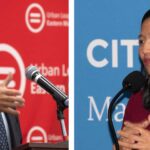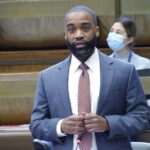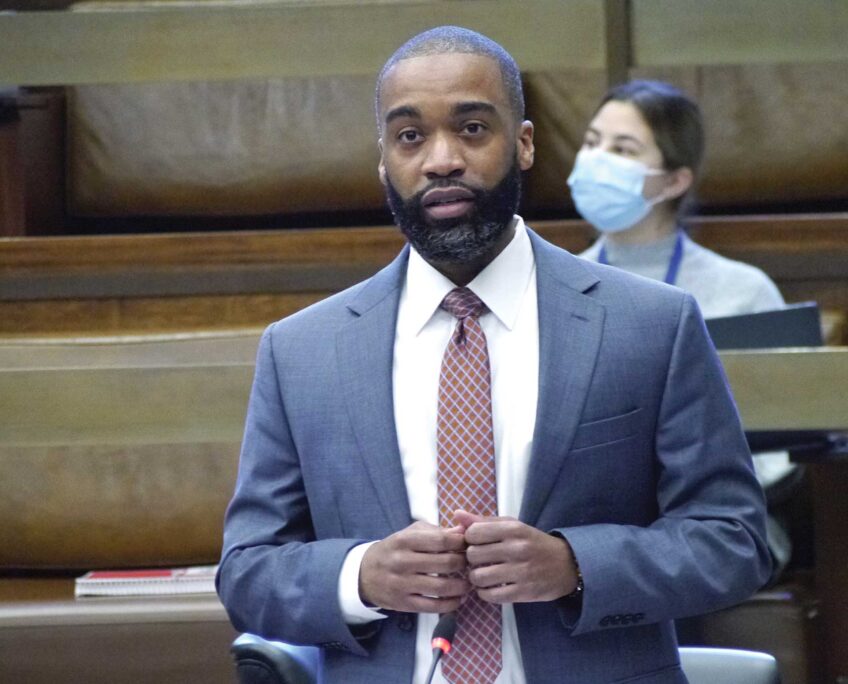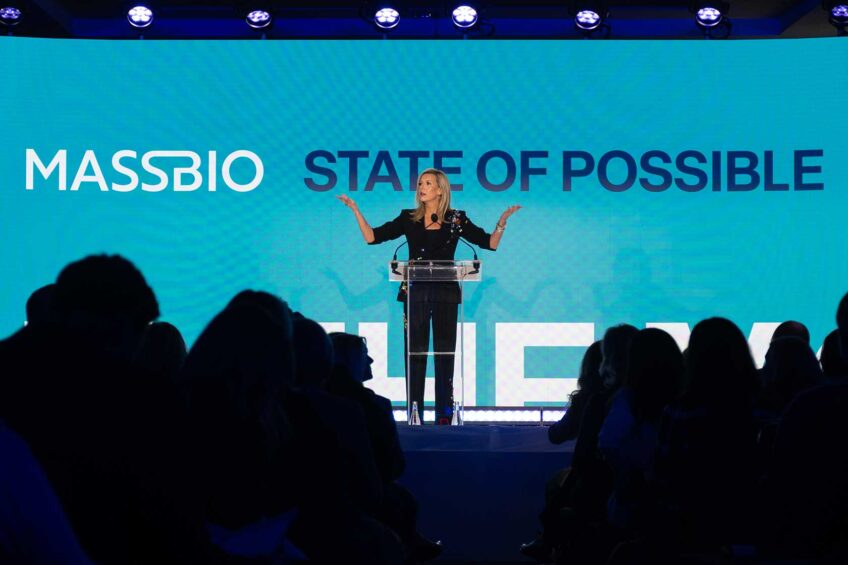How urban renewal shaped Boston Look at the past as city plans for future
State Rep. Byron Rushing gives talk on suburbanization, the BRA, gentrification
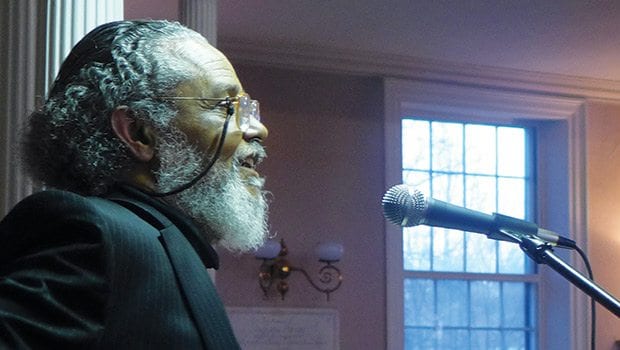
Community members gathered at the First Church Roxbury last week to hear State Rep. Byron Rushing speak as part of a series on structural racism in Boston. His talk, “Urban renewal then, gentrification now,” traced the history of Boston’s urban renewal and how profiteering, top-down policy decisions and prejudice contributed to shaping the city’s neighborhoods.
Today, the shape of Boston’s growth again is focus. The Walsh administration is developing a citywide plan for 2030 and examining how to house Boston’s growing population. Meanwhile, a 2014 Brookings report declared Boston the most unequal large city in America. Chief Resilience Officer Atyia Martin said at the event that, based on five months of community engagement, her department has selected tackling racial inequities and “promoting social cohesion” in the city as the guiding theme for its work.
The underlying theme of gentrification, Rushing said, is mobility inequality — that is, inequality in people’s abilities to determine where they live, with the haves making choices and the have-nots subject to decisions imposed on them.
“What we call gentrification is in many ways the movement of people in a city,” he said. “What makes some people find it objectionable is that the movement of those people doesn’t seem equal.”
Birth of suburbia
After World War II, people flooded into the cities, and as veterans returned, housing was in scarce supply, Rushing said.
The federal government provided veterans with subsidies to help them buy housing — an opportunity developers quickly jumped on. Developable land was expensive in the tightly-packed cities and rehabilitating the cities’ old buildings to provide housing was a costly endeavor. So developers sought the greatest return on investment: persuading veterans to buy newly-built houses in areas that formerly was farmland.
“[The veterans] could buy that housing any place,” Rushing said, “but, of course, developers realize the best way and most profitable way to sell them housing is to sell new housing. And so that’s the beginning of suburbanization in this country.”
Emergence of urban renewal
The suburbs were largely an escape for those with means, whether from government aid or wealth. Racial discrimination was a significant factor as well: With no civil rights laws yet restraining them, many banks and authorities refused to offer housing subsidies or mortgages in the suburbs to people of color.
Cities were growing crowded, with Boston’s population soaring from 770,000 people in 1940 to a record-breaking 800,000 people in 1950, Rushing said. In the midst of this, Rushing said, municipal governments sought to make cities seem more livable and enticing. Many central cities had crumbling infrastructure and housing and limited space for development. The proposed solution: redevelop cities. The tool for that: urban renewal.
In 1949, the federal government launched an urban renewal program, providing funding for city governments to acquire land for redevelopment and revitalization. Boston officials used the power of eminent domain to purchase areas they deemed deteriorated. Rushing said that residents in these neighborhoods were largely poor renters and saw little benefit from the process; developers who owned the homes made money selling them to the city, while renters were evicted with no guarantee of regaining a place to live.
West End and the BRA
Boston’s first urban renewal target was a series of South End blocks known as “The New York Streets,” which were demolished. The land was redeveloped as headquarters for the Herald-Traveler newspaper and a few other commercial buildings. With this project under their belts, city officials turned to a larger prospect: the West End.
As was the case in many cities, local officials sought to win community support for redevelopment. Rushing said that working class residents of the West End were encouraged to view their neighborhood as a slum, and that this message was promoted via comic books distributed to public school children, among other methods. These efforts achieved mixed success, and the city proceeded to demolish most of the West End and in their place construct a highway, housing, commercial and government buildings.
Widespread outcry over the massive destruction forced the city to take a new approach. The Boston Redevelopment Authority was organized and given control of urban renewal; the city recruited as director Ed Logue, who had gained a reputation in New Haven for choosing rehabilitation over demolition.
Black Boston
Meanwhile, racial division was stark in the ‘60s and ‘70s, with most of Boston’s approximately 63,000 black residents packed into the South End and Roxbury, creating overcrowding. Banks largely refused to offer blacks mortgages in other areas, making it difficult to move out. The city’s housing planning ignored housing problems in Roxbury, and many in the black community did not feel they had leaders who could advocate on it, Rushing said. Then, in the ‘60s, fears of unrest spurred city officials to address problems of density and segregation.
Long-simmering anger over Roxbury’s living conditions erupted in 1967. The catalyst: Boston police responded to a group of mothers’ five-day sit-in protest over welfare benefits by dragging the women out of the Grove Hall welfare office building. Black leadership was not consulted or forewarned, and many in the community had regarded the protest as ordinary. The reaction: riots.
“It was ‘The Event,’” Rushing said. “The anger flared up. In two hours, buildings and stores were burning on Blue Hill Avenue.”
When the assassination of Martin Luther King Jr. a year later sparked violent outbursts across the nation, Boston officials feared another riot. Turning with a new sense of urgency to black residents’ complaints, the city administration asked bankers to help black residents expand further into the city. A group of bankers created the Boston Bank Urban Renewal Group, selected areas of Dorchester and Mattapan — primarily home to working class Jews — and offered blacks mortgages there. As Jews sold homes and left, blacks entered.
South End
The story of the South End provides a new chapter on urban renewal, as the racially diverse neighborhood of primarily poor working-class homeowners mobilized. Existing organizations and ones created specifically to deal with the BRA made demands on a project-by-project basis for building rehabilitation — instead of demolition and new construction — and establishment of long-term affordability rent subsidies. Original residents remained in their neighborhood, and as urban renewal created new housing options, middle class white people moved in as well.
The influx of residents in part comprised lesbians with the means and gay men seeking the greater anonymity offered by cities and the lessened prejudice that brought with it. Also arriving: members of the middle class leaving the suburbs for the liveliness of cities. Whites were particularly drawn to the South End over Roxbury, because the South End’s the racial mix meant they would not be in the minority, Rushing said.
The new South End comprised working class blacks and a growing Hispanic population in guaranteed-affordable housing, a growing gay community and other middle class whites.
Rise of condos
With people flowing into the South End and housing costs rising, developers introduced in the mid-70s the idea of condos, marketing to potential customers the chance to buy part of a building if the whole was outside their reach.
“These buildings are getting too expensive to buy. Buy a piece of it,” Rushing said. “The value of buildings literally changes fourfold by just changing the deed to make it a condominium deed.”
Condos play a special role in gentrification by allowing a greater influx of upper-class newcomers, shifting demographics of the community, Rushing said.
“One rich family doesn’t make gentrification,” Rushing noted. “They could just be the eccentric people who live in the biggest house at the top of the hill. … For those people who think an area’s getting gentrified and want to do something about it, the first thing you do is zone for no condominiums.”

